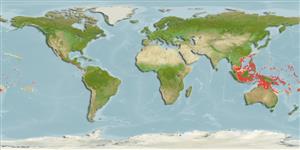Common names from other countries
Environment: milieu / climate zone / depth range / distribution range
นิเวศวิทยา
เกี่ยวกับทะเล,น้ำเค็ม เกี่ยวกับหินโสโครก; ไม่มีการอพยพย้ายถิ่น; ระดับความลึก 3 - 70 m (Ref. 4859). Tropical; 30°N - 23°S
Western Pacific: Ryukyu Islands to Indonesia, the Solomon Islands, the Great Barrier Reef and New Caledonia (Ref. 48391). Palau and Kapingamarangi in Micronesia (Ref. 1602).
ขนาด / น้ำหนัก / Age
Maturity: Lm ? range ? - ? cm
Max length : 10.0 cm TL เพศผู้/กระเทย; (Ref. 48636)
เงี่ยงครีบหลัง (รวม) : 14 - 15; ก้านครีบอ่อนที่หาง (รวม) : 16 - 17; เงี่ยงครีบก้น: 3; ก้านครีบอ่อนที่ก้น: 16 - 17.
Common in coral-rich areas of outer reef slopes, occasionally sighted in lagoons and passages. Prefers habitats with rich mixed invertebrate growth (Ref. 48636). Usually seen singly or in pairs. It thrives well in an algae-grown tank (Ref. 4859). Feeds on algae. Forms harems of 3-7 individuals. Frequently exported through the aquarium trade (Ref. 48391).
Life cycle and mating behavior
Maturities | การสืบพันธุ์ | Spawnings | Egg(s) | Fecundities | ตัวอ่อน
Steene, R.C., 1978. Butterfly and angelfishes of the world. A.H. & A.W. Reed Pty Ltd., Australia. vol. 1. 144 p. (Ref. 4859)
IUCN Red List Status (Ref. 130435)
CITES (Ref. 128078)
Not Evaluated
Threat to humans
Harmless
Human uses
การประมง: การค้า; สถานที่แสดงสัตว์และพืชน้ำ: การค้า
เครื่องมือ
Special reports
Download XML
แหล่งที่มาจากอินเตอร์เน็ต
Estimates based on models
Preferred temperature (Ref.
115969): 26.3 - 29, mean 28 (based on 520 cells).
Phylogenetic diversity index (Ref.
82804): PD
50 = 0.5000 [Uniqueness, from 0.5 = low to 2.0 = high].
Bayesian length-weight: a=0.03090 (0.01359 - 0.07026), b=2.89 (2.70 - 3.08), in cm Total Length, based on LWR estimates for this (Sub)family-body shape (Ref.
93245).
ระดับชั้นอาหาร (Ref.
69278): 2.8 ±0.29 se; based on food items.
ความสามารถในการกลับคืนสู่ปกติ (Ref.
120179): ความสูง, เวลาต่ำสุดที่จะทำให้ประชากรเพิ่มขึ้นเป็น 2 เท่าใช้เวลาน้อยกว่า 15 เดือน (Preliminary K or Fecundity.).
Fishing Vulnerability (Ref.
59153): Low vulnerability (10 of 100).
